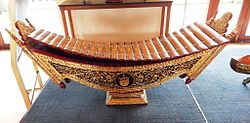Pattala
 | |
| Percussion instrument | |
|---|---|
| Other names | Burmese xylophone |
| Classification | Percussion instrument |
| Developed | Before 1479 |
| Related instruments | |
| Ranat ek,Roneat ek | |
| More articles or information | |
| Music of Myanmar | |
Thepattala(Burmese:ပတ္တလားpatta.la:,Burmese pronunciation:[pattəlá];Mon:ဗာတ် ကလာ) is a Burmesexylophone,consisting of 24 bamboo slats calledywet(ရွက်) orasan(အဆံ) suspended over a boat-shaped resonating chamber.[1][2]It is played with two padded mallets.[1][2]The pattala is tuned similar to thediatonic scale.[1]
In modern days, classical Burmese chamber music is accompanied by either the pattala or thesaung(the Burmese harp), both of which are capable of performing a harmonic countermelody.[3]The pattala is also a key instrument in the Burmese ensemble orchestra, thehsaing waing.[4]The pattala is also prominently featured in Burmese drama,anyeint.[5]
Etymology[edit]
The Burmese termpattalais a calque ofSanskritvādya(ဝါဒျ, "musical instrument" ) andMon(ကလာ, "chest" ). The Mon equivalent is calledpatkala(ဗာတ်ကလာ). In the Karen languages, it is calledpaw ku.[6]
Origins[edit]
The earliest extant mention of thepattalais in theKalyani Inscriptions,which dates to CE 1479, followed by a reference in a treatise during the reign ofBayinnaung.[5]During the Nyaungyan era, the pattala was referenced in the poet-ministerPadethayaza's verse poem, "Thuza Pyo"(သူဇာပျို့) as an instrument played for royal court affairs. The pattala is similar to other mainland Southeast Asian instruments, including the Thairanat ekand the Cambodianroneat ek.
In pre-colonial Burma, the pattala was used in royal court music.[7]In fact, when thepianowas first introduced to the Burmese court in the late 1800s, it was tuned to thescaleof the pattala.[7]
Construction[edit]

The bamboo slats are typically made from the wood of giant bamboo (Dendrocalamus giganteus), which is durable and produces a stable sound.[1]Slats are occasionally made frombrassoriron.[1]The mallets are made from hardwoods such asteak,padauk,black cutch,yindaik, or pyinkado.[1]The resonance box is made fromteakand decorated with inlaid glass or gold leaf.[1]
Thepattala's components have specialized names in the Burmese language:[8]
- Pallin(ပလ္လင်, lit. "throne" ) — the base of thepattala[8]
- Phanat(ဖိနပ်, lit. "shoes" ) — the foot of thepattala[8]
- Bedaungbya(ဘဲတောင်ပြား, lit. "flat duck feathers" ) — the resonating chamber[8]
- Myinmo taing(မြင်းမိုရ်တိုင်, lit. "Mount Merupillars ") — decorative protrusions from the resonating chamber[8]
- Myinmo peik(မြင်းမိုရ်ပိတ်, lit. "Mount Meruclosure ") — either end of the resonating chamber[8]
See also[edit]
References[edit]
- ^abcdefgGiản lược ung dung cuồng dã.Quốc lập truyền thống nghệ thuật trung tâm. 2006. pp. 112–113.ISBN9789860059182.
- ^abA Description of the Burmese Empire.Oriental Translation Fund of Great Britain and Ireland. 1833. pp.128.
- ^Rice, Timothy (2011).Ethnomusicological Encounters with Music and Musicians.Ashgate Publishing. p. 185.ISBN9781409434023.
- ^Brandon, James R. (2009).Theatre in Southeast Asia.Harvard University Press. p. 127.ISBN9780674028746.
- ^ab"Musical Instruments - Xylophone (Pattala)".Union of Myanmar Ministry of Hotels and Tourism.2006.Retrieved31 August2013.
- ^Cooler, Richard M. (1995).The Karen Bronze Drums of Burma.BRILL. p. 29.ISBN9789004099333.
- ^abParakilas, James; E. Douglas Bomberger (2002).Piano Roles: A New History of the Piano.Yale University Press.ISBN9780300093063.
- ^abcdef"မြန်မာ့အနုသုခမ အဘိဓာန် Dictionary of Myanma Performing and Plastic Art".WAING.Retrieved2020-05-04.
